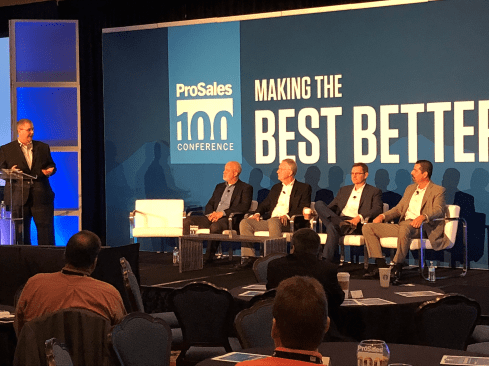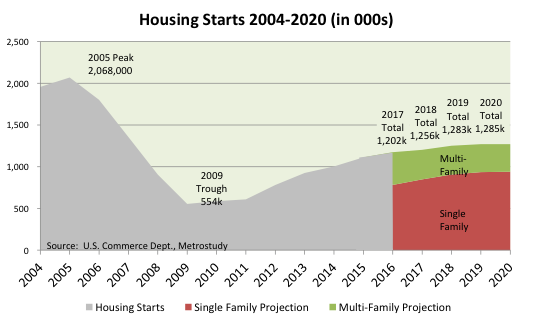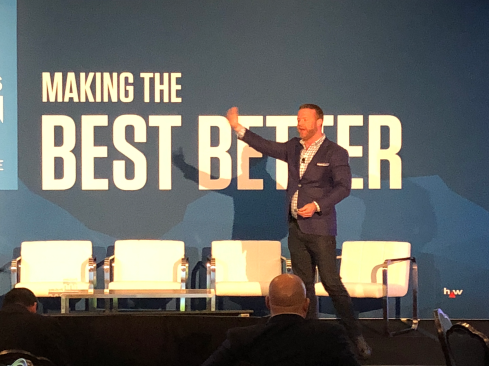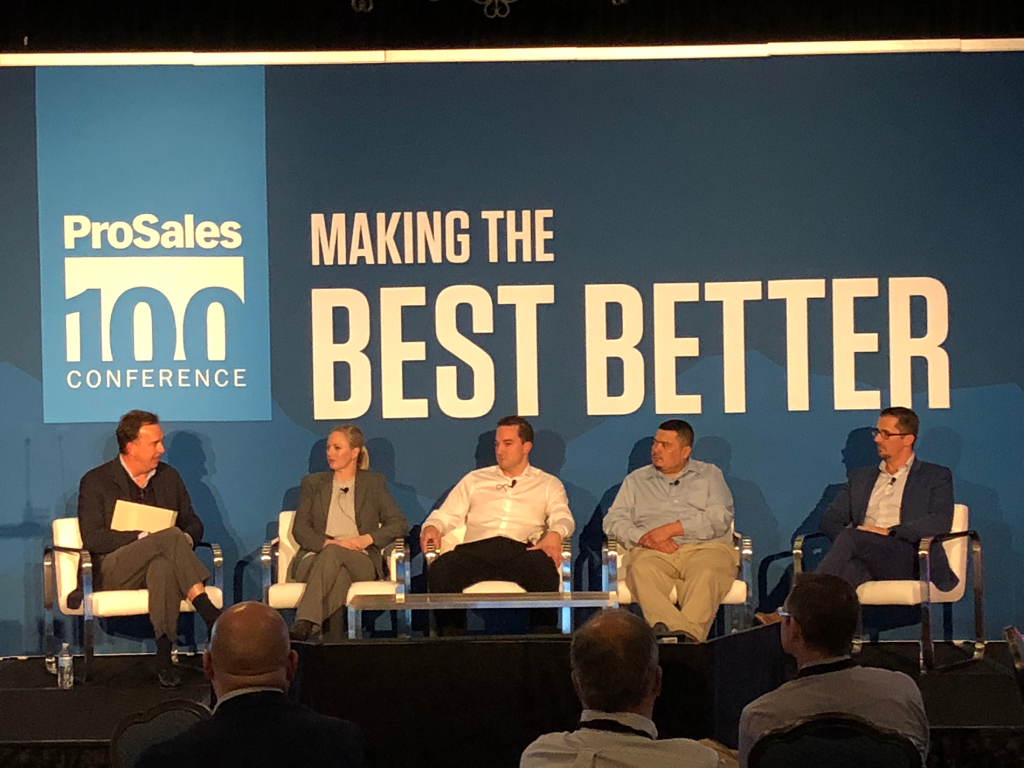The record-sized audience of dealers, distributors and building product manufacturers loaded their notebooks and took scores of screen shots in San Antonio on March 1-2 during the educational sessions of the ProSales 100 Conference. Every attendee has their own list of top takeaways. Here are some of our favorites.

Craig Webb
Michael Collins leads the M&A panel at the 2018 ProSales 100 Conference. Seated from left are Chad Crow, Builders FirstSource; Dave Dittmer, TAL Holdings; Steve Swinney, Kodiak Building Partners; and Ruben Mendoza, Foundation Building Materials.

Metrostudy
What Inning Are We in?
Economists, mergers and acquisition experts, and dealers who want to sell or buy operations have taken to use baseball as a metaphor for assessing where we are in housing’s current economic cycle. Chad Crow, CEO of Builders FirstSource, thinks we’re still in the sixth inning, as does Metrostudy Chief Economist Mark Boud. Ruben Mendoza, head of Foundation Building Materials, and David Dittmer of TAL Holdings think we’re in the middle of the seventh. And Kodiak Building Partners’ Steve Swinney declined to use the baseball analogy, saying instead that we still have a long way to go. The bottom line: Expect the housing economy to stay robust in 2018 and 2019 before leveling out around 2020. For 2018, Boud thinks housing starts will rise to 1,256,000, and then climb to 1,285,000 in 2019.
Driving Point
Mark Boud says his role as Metrostudy’s chief economist often requires him to create forecasts based on what he thinks life will be like 20 years from now–even 25 years ahead in the case of Hawaii, because projects take so long there. That means he thinks a lot about technology’s future impact. For instance: He can envision a day in which commuters will ride home in their self-driven cars and then get dropped off at their house, at which point the car will drive itself to a facility run by the local home owner association where the electric vehicle will get recharged, washed, and serviced.
Gamesmanship
Most every session touched in some way on the labor shortage and the need to get the next generation interested in a construction career. Kyle Tibbetts, board chairman of Florida’s Tibbetts Lumber, thinks one way to do that is to find connections between what young people like to do and what construction people do. For instance, he noticed one of his children playing the video game Minecraft and realized the child was in effect building a city. That’s not much different than the computer-aided design programs home builders use. So Tibbetts is encouraging his child’s school to consider the connection.

Craig Webb
Jason Forrest speaks at the 2018 ProSales 100 Conference
Let It Go
Seventy percent of training fails to produce a positive return on investment, consultant Jason Forrest told the group. What constitutes good training? To Forrest, part of training should include having as few rules as possible. Why? Because lots of rules that companies create aren’t really meant to help the firm achieve its objectives. Focusing on what really matters frees up creativity and simplifies things.
Ever More Efficient
Lean operations is one of the biggest trends in LBM, and it was clearly on the minds of participants. Paulo Sitolini, chief operating officer of Hayward Lumber, said during the executive panel that he’s been focusing on how his company uses its trucks. That research includes assessing not only what percentage of trucks leave California-based Hayward’s yards fully loaded, but whether the company would be better off buying smaller trucks would produce bigger returns on investment.
NASCAR Comes to Cape Cod
Shepley Wood Products operations director Tom Dias used his appearance on the lean operations panel to summarize how his Massachusetts-based company worked to speed its delivery trucks’ turnaround times. With help from consultant (and session moderator) Scott Morris, Shepley adopted a “pit stop” mentality in which its yard crews were organized to work both separately and in concert to get trucks in and out of the distribution center faster than its 46-minute average. In eight months, Shepley was able to cut the turnaround time to an average of 28 minutes. That in turn enabled it to increase the average number of deliveries to 655 per week from 620. Dias said one key to success was designating a staff to a new job in which he checks on every load as it gets prepped.
A Digital Road Map
Everybody knows social media is growing in importance, but how should you embrace it? Scott Ericsson and Jennifer Swick of Wheelhouse 2020 sought to make things less confusing by presenting a digital road map. It starts with foundational work, much of it around learning what’s out there and getting terms straight. Next should come search engine optimization, so that people using Google and similar search engines are more likely to find you when they go online for help. After that, get into social media, they said. Prime examples include Twitter, Facebook, and Snapchat, with Houzz and LinkedIn trailing. But make sure that the traffic you’re getting from this effort actually brings you the type of customers you want, they cautioned. Milepost No. 4 on the digital journey concerned reputation management and advice to keep an eye on reviews and comments that people are making online about you. And finally there’s outbound social media marketing, such as putting ads on Google.
On a Mission
Chris Goebel, CEO of Star Lumber, Wichita, Kan., volunteers in a high school where he connects 25 kids with Star’s trade customers. By doing so, “They realize there is money to be made and construction can be fun,” Goebel said of the students. “They don’t have to drive nails their whole careers.” Meanwhile, Sitolini says contractors in his areas who serve as mentors wear shirts with the numbers 17 and 29 on their backs. When kids ask what the numbers mean, the mentors reply that 17 represents the starting hourly wage in construction in the area, while 29 is the hourly wage a journeyman can get.
Outside Assistance
Wilson family members hold some of the senior jobs and all the board positions at Wilson Lumber, so Robb Wilson supplemented that insider knowledge by having four trusted outsiders serve on an advisory council that meets with him a couple of times a year.



